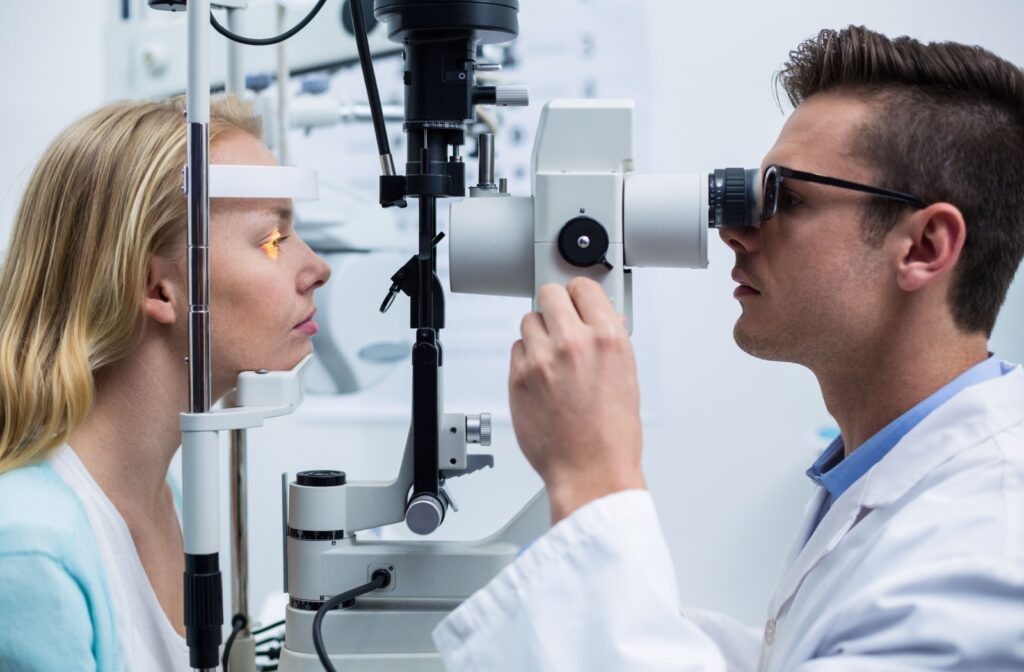About 75% of vision loss is preventable and treatable if detected early through regular eye exams, making these appointments crucial. Yet, many Canadians skip their regular eye exams, and it’s not always due to a lack of coverage.
Some have the benefits but simply don’t use them. Reasons vary—some believe the cost is too high, while others avoid exams because they aren’t experiencing noticeable vision loss or are unsure what services their insurance covers.
Understanding what services the Ontario Health Insurance Plan (OHIP) covers can sometimes feel like solving a complex puzzle. Eye care is an essential aspect of overall health, but are eye exams covered by OHIP?
OHIP doesn’t fully cover all eye-related services, and the exact coverage depends on various age-based eligibility criteria. It can be helpful to consult with the eye doctors at Mint Eyecare about coverage options before your appointment.
OHIP Coverage Basics
OHIP is Ontario’s provincial health insurance program that covers medically necessary physician and hospital services. However, it’s important to understand that OHIP does not cover all healthcare services. Some medical procedures, treatments, and tests may not be fully covered or are only partially covered.
Recent changes in Ontario’s coverage have affected certain individuals. Starting September 1, 2023, only those aged 20-64 with chronically progressive conditions will be covered. Seniors and children will continue to have coverage, though with some specific conditions.
OHIP Coverage for Eye Exams in Ontario
Routine Eye Exams
In Ontario, routine eye exams, which assess vision, overall eye health, and prescribe corrective lenses, are not typically covered by OHIP for individuals aged 20 to 64. As a result, many adults in this age group must either pay out-of-pocket or use private insurance to cover the cost of these exams.
Specific Populations Covered
OHIP does offer coverage for certain groups:
- Individuals under 20 or over 64 with specific sight-threatening conditions are eligible for one comprehensive eye examination annually.
- Patients aged 65 and over without a serious sight-threatening condition (effective September 1, 2023) are eligible for an OHIP-covered comprehensive eye exam from an optometrist once every 18 months.
Exceptions to the Rule
OHIP may also cover medically necessary eye exams for individuals of any age with specific eye conditions. These include diabetes, glaucoma, cataracts, and progressive retinal diseases, among other qualifying conditions. Coverage is based on the medical necessity of the exam and meeting specific qualifying criteria.
Alternative Options for Eye Care
For those not covered by OHIP for routine eye exams, several alternatives are available to access eye care services:
Private Insurance
Many employer-sponsored or individually purchased insurance plans include coverage for routine eye exams and vision care expenses. It is crucial to review your insurance policy details to understand what is covered and any associated costs or limitations.
Out-of-Pocket Payment
Without insurance coverage for eye exams, costs for services rendered will need to be paid out-of-pocket.

Importance of Regular Eye Exams
Regular eye exams are crucial at every stage of life, serving as a cornerstone for maintaining good vision and overall eye health. The frequency of these exams can vary based on age and individual risk factors, but here are our general recommendations:
For Children
Annual eye exams are recommended for children aged 4 to 19 to monitor their vision development and catch any early signs of eye conditions. Regular checkups can help address any issues affecting learning and development promptly.
For Adults
Adults between 20 and 64 should have an annual eye exam to maintain optimal vision and eye health. Early detection of conditions such as glaucoma, cataracts, and macular degeneration is vital, as many eye diseases can progress without noticeable symptoms.
For Seniors
Annual eye exams are also essential for older adults aged 65 and over. Aging increases the risk of eye diseases and conditions that can impair vision, such as age-related macular degeneration and diabetic retinopathy. Regular checkups can help manage these issues effectively.
Adjusting Frequency Based on Individual Needs
Your optometrist may recommend more frequent exams based on several factors:
- Eye health: More frequent monitoring may be necessary if you have existing eye conditions or vision problems.
- Personal and family medical history: A family history of eye diseases or other health conditions like diabetes can increase your risk, necessitating more regular checkups.
- Risk factors for eye diseases: Factors such as prolonged exposure to UV light, high prescription glasses, or contact lens usage can also influence the need for more frequent examinations.
Eye Care in Ontario
Although OHIP typically does not cover routine eye exams for adults aged 20 to 64, it’s essential to prioritize eye health by scheduling regular comprehensive eye exams, especially for children, older adults, and those with specific eye conditions.
Ontarians can make sure they receive necessary eye care by staying informed about coverage options, taking advantage of private insurance, exploring community programs, or choosing to pay out-of-pocket.
Remember, proactive eye care is vital for maintaining optimal vision and overall well-being for people of all ages. We at Mint Eyecare encourage you to reach out and book your eye exam today!




